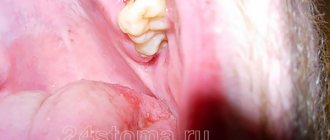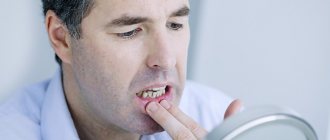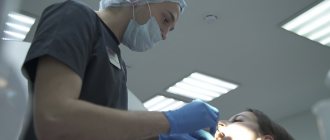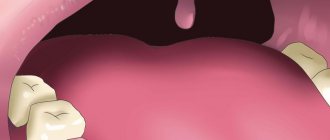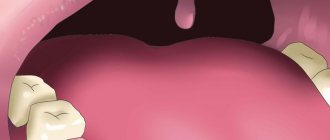Often, the dentist prescribes antibiotics to the patient after the removal of a wisdom tooth in order to avoid unpleasant consequences or complications. The main indicators of antibiotic therapy include the development of the inflammatory process in the formed hole. More information about the choice of antibacterial drugs will be discussed in this article.
Antibiotics after wisdom tooth removal
Content:
- The use of antibiotics during tooth extraction for preventive purposes
- Antibiotics after tooth extraction with inflamed gums
- When you can't do without antibiotics
- Types of antibiotics used in dentistry
- What are the consequences of not taking antibiotics?
Only the dentist can decide whether to prescribe an antibacterial drug to a patient or not.
The need for its use does not always arise. If the operation was uncomplicated and the likelihood of complications is minimal, additional drug therapy is usually not required. Even if after tearing out a unit the body temperature has increased, this is not an indication for antibiotic therapy. The body adequately responds to the inflammatory process and does everything necessary to block the spread of pathogenic microflora. Normally, already on the 3-4th day the patient’s condition is completely normalized, the pain goes away, the swelling subsides.
When do you need to see a doctor urgently?
If a high temperature (more than 38 degrees) lasts longer than a day, and severe swelling is observed, accompanied by an unpleasant odor and taste in the mouth, a doctor’s consultation is necessary. You should immediately see a doctor if the bleeding does not stop for more than 10 hours.
Also reasons to contact a specialist are:
- external signs of seam divergence;
- the appearance of pain in the socket that does not subside for more than 3 days, increasing or pulsating;
- mobility of adjacent teeth;
- numbness of the tongue, cheeks and lips;
- soreness of the submandibular lymph nodes.
Do not ignore the recommendations described above, as this can lead to serious complications and long-term treatment, including in a hospital setting.
Antibiotics after tooth extraction with inflamed gums
A few days after the extraction, the patient visits the dentist who performs the operation. The doctor assesses the course of regenerative processes. If it turns out that the inflammatory process has spread and there is a high probability of a bacterial infection, then antibiotics are immediately prescribed. They create conditions for the speedy restoration of damaged mucous membranes.
The most common reasons why antibiotic therapy is necessary after removal of radical units:
- non-compliance with medical prescriptions, due to which the hole became inflamed;
- too active rinsing of the mouth, which caused the displacement of the protective blood clot;
- slow healing associated with the individual characteristics of the human body.
After studying the specifics of the situation, the doctor decides which medications to prescribe. In some cases, it is possible to get by with local application of antibacterial gels and ointments. For severe inflammation, oral medications are prescribed.
Main activities after extraction
As soon as the tooth is removed, the doctor treats the empty socket and places a cotton swab soaked in the medicinal composition into it. In some cases, stitches may be required. On the recommendation of the dentist, the tampon is removed several hours after the manipulations.
During this time period, it is forbidden to eat, smoke, drink, talk, that is, it is better not to open your mouth at all. You should also not touch the hole with your fingers or insert foreign objects into it. To disinfect (disinfect) the oral cavity, you should use Furacilin, Miramistin, Chlorhexidine, Chlorophyllipt.
Important! To prevent postoperative bleeding, you should not bend over, lift heavy objects, visit saunas, or take hot baths.
Upon completion of the extraction, patients can be prescribed antibacterial compounds in various dosage forms - tablets, capsules, drops, local solutions and applications
When you can't do without antibiotics
If after extraction a secondary inflammatory process has developed, affecting the trigeminal nerve, alveolar ridge, periosteum, there is nowhere without antibiotic therapy. It is also carried out if:
- the operation was complex (for example, the “eight” was pulled out);
- a large amount of purulent exudate is released from the hole;
- alveolitis has developed, body temperature is elevated, the wound is infected;
- periodontitis was diagnosed, spreading to the tissues that are located next to the extracted tooth;
- osteomyelitis was identified, which contributes to the formation of fistulas;
- periostitis progresses, has spread to the periosteum;
- After the operation, flux developed at the removal site, and the face became very swollen.
It is very important that in case of any complications the patient visits the dental clinic and does not self-medicate, experimenting with different pharmaceutical drugs and folk recipes.
Possible complications
Incorrect dosage, non-compliance with the rules for taking medications, as well as incorrectly selected medications can provoke the following unpleasant consequences:
- Alveolitis is an inflammation of the socket of an extracted tooth.
- Periodontitis is an inflammatory process that develops in the soft tissues surrounding the empty socket.
- Flux is inflammation of the periosteum.
- Osteomyelitis is purulent-necrotic processes affecting the jaw bone tissue.
So, in modern dental practice, after tooth extraction, if there are indications (inflammatory processes, certain chronic diseases, problems with blood clotting), it is customary to prescribe antibacterial therapy. Why are such drugs needed?
The main task of antibiotics is to fight pathogenic microflora: pathogens of inflammation, the cause of suppuration and a number of other postoperative complications. Whether it is necessary to take medications is decided in each specific case by the dentist, based on the characteristics of the individual patient’s body and the presence of concomitant dental (systemic) diseases.
Types of antibiotics used in dentistry
To eliminate the symptoms and consequences of dental diseases, antibiotics of the following pharmacological groups can be used:
- Penicillins. The largest category of antibacterial agents. They are characterized by a wide spectrum of action and effectively destroy pathogenic microorganisms. They can be injected or used in tablet form.
- Macrolides. Remedies that are often used for diseases of the ENT organs. Dentists prescribe them only if the patient has poor tolerance to other antibacterial drugs or the pathogen is insensitive to penicillins.
- Cephalosporins. Medicines exhibiting excellent bactericidal properties. In dental practice, two representatives of the group are most often used - Cefaclor and Cephalexin.
- Lincosamides. Medicines that effectively control the inflammatory process. With their help, you can quickly eliminate inflammation and prevent further progression of dental complications. A popular representative of lincosamides is Lincomycin. It can be bought in the form of tablets, injections, ointments. The latter is suitable for tamponade of the inflamed socket.
- Fluoroquinols. Contains tsifran - a component that quickly destroys pathogenic flora. Indicated for purulent complications.
- Aminoglycosides. They are prescribed after extensive dental operations, if the wound is infected or the infection has entered the blood.
- Tetracyclines. They act by blocking protein synthesis in microbial cells. These include Oletetrin, Doxycycline. It should be noted that today tetracyclines are used less and less, since many modern infections are little sensitive to their active substance.
Treatment rules
The oral cavity is home to “healthy” rich microflora. Taking antibacterial drugs causes the death of the necessary lacto- and bifidobacteria and leads to a rapid increase in the number of pathogenic strepto-, pneumo-, and staphylococci.
Important! Taking antibiotics for dental diseases harms the microflora of the oral cavity in any case, regardless of which dosage form of the drug was chosen by the attending physician (oral medications, injections, capsules, drops, applications).
Treatment with antibiotics excludes the use of alcoholic beverages, psychotropic, sleeping pills and narcotic drugs. If we are talking about tablets, capsules or local antibiotics, then they are used an hour before or 2 hours after a meal, otherwise the absorption of the drug will be complicated. Take the tablets with warm boiled water.
How many days to take antibiotics: if there is no therapeutic effect after 2-3 days from the start of treatment, the drug must be replaced (or the dosage adjusted). Pregnant and lactating women, children, and patients with chronic diseases can take antibiotics only after consulting a doctor.
Antibiotics do not cope with pain and swelling, so patients who have undergone extraction are additionally prescribed antihistamines, anti-inflammatory and painkillers
What are the consequences of not taking antibiotics?
If a doctor has prescribed a medicine, but the patient does not want to take it because of some personal beliefs, the situation often turns against him. It may turn out that the doctor’s worst fears will come true - the inflammatory process will spread to the jaw bone. Then osteomyelitis will develop.
This purulent disease is quite insidious. It can affect internal organs and cause sepsis, which, in turn, can be fatal. Therefore, you should not argue with the dental surgeon and ignore his appointments. Take care of your health.
Side effects
Long-term use of antibiotics may cause side effects
Their manifestation can be triggered by incorrect selection and prescription of the drug, as well as if the rules for its use have been violated.
The pharmacodynamics of antibiotics is based on the absorption of the active substances of the drug by the intestines, followed by its distribution throughout all tissues of the body.
The active substances of the antibiotic undergo breakdown in liver cells and, together with bile, feces and urine, are excreted from the body.
With long-term use of the drug, the following side effects may occur:
- Development of dysbacteriosis or candidiasis.
- Attacks of nausea.
- Vomiting.
- Inflammatory processes in the oral cavity.
- Allergic dermatitis on the skin of the body and face.
- Minor vascular bleeding in the oral cavity.
- Kidney and liver dysfunction.
- Weakening of the body's protective functions.
Important! If side effects occur, you should immediately stop taking the drug and replace it as prescribed by your doctor.

